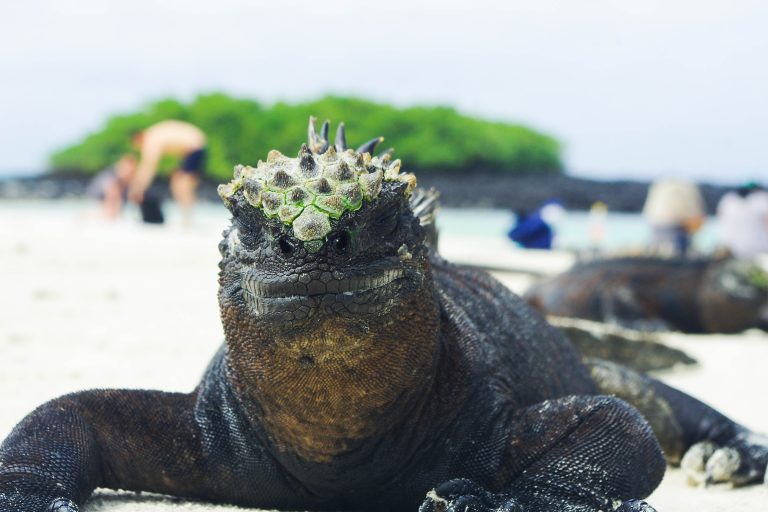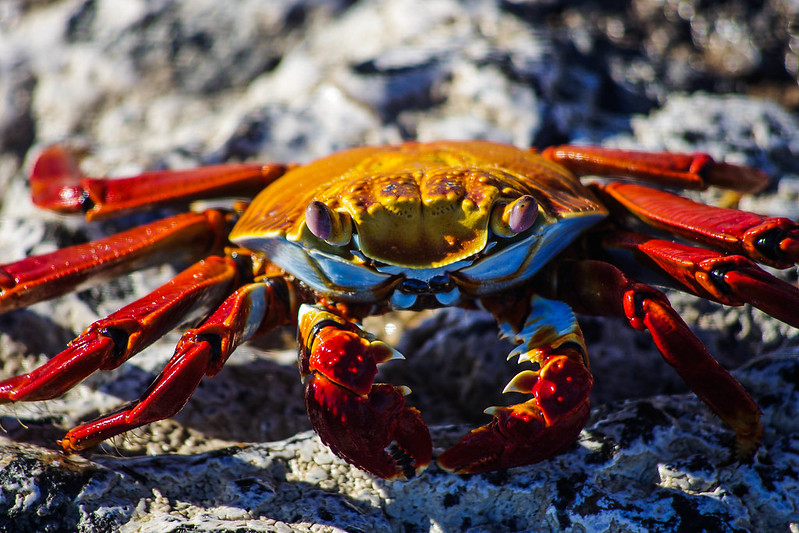The Galapágos are the world as we do not expect it, as we hope it is and as it must remain
There are unexpected places on this planet where beautiful and surprising things await us. Somewhere, nature has taken liberties with the diktats of beauty, style and how to be happy. Somewhere, living beings have shaken up the codes and are teaching us about being and seeing. To the east of the Pacific Ocean, which bears its name so badly cause it seems to be always angry, lies an archipelago 1000 km west of the Equator: the Galapagos Islands.
Here, the most beautiful trees are not trees
In the Galapagos, the cactus have the shape of a tree and yet they are cactus, more exactly prickly pears. They rise up with the clumsy majesty of a little girl wearing her mother’s elegant shoes. It is as if these cacti have been dreaming all their lives of rising from their condition and of rising higher. Stubborn dendrophiles, they have succeeded in their wager: to become something other than what they were destined for by unbreakable laws.
On their powerful and compact reddish-brown oiled trunk, they carry their heavy, racket-shaped leaves filled with thorny fruit. They do not have the finesse of a lime tree nor the lightness of a birch tree. They are thick and hairy, of a slightly faded green, with a heavy silhouette. And yet, they are of a touching majesty. Without them, land iguanas would starve to death, without them these islands would look like all the others.
Here, the perfume is wild and cannot be bought
The Galapagos forest can’t choose between desert, tropics or jungle.
There is a strange perfume secreted by the trees, a powerful scent that remains on the hands like an evil and delicate ointment. It is a crazy mixture of thyme, rosemary, camomile, ripe fig, lavender, patchouli. It is the unique perfume of the forests of these islands.
Here, curious onlookers have wings and invite themselves into the intimacy of the visitors
In the Galapagos like nowhere else, birds are curious about humans, they are not afraid. They follow us, from tree to tree, nodding, whistling, not losing sight of us. They talk, consult each other, rub shoulders with other as humans would. On the beach that borders the forest, tiny black birds, the size of sparrows, turn around me, settle on my towel, jumping slightly, inspect my backpack, my camera. Once, twice, ten times, they look at my book with curiosity. A few centimetres from my hands, my feet powdered with white sand. I really feel like I rudely invited myself into their house. house.
The Galapagos are constantly renewing the decorations: hard and soft, dry or tender, incandescent or icy
The paradise of the Galapagos was born from the fires of hell and the wrath of the ocean
Here, volcanoes are everywhere. Black rocks, pure coal, metallic slag, hell of basalt, are bursting on the immaculate beaches, on the cliffs heckled by the furious swell.
Still as hard and rough after a thousand years. So intense black, they are blue.
We can hear the strange sound of metal being pulverised beneath our feet. We can see the folds and folds of the lava that has flowed down to the sea with the consistency of a thick honey. We can still see the bubbles of the magma that didn’t have time to burst, the curves, the heavy heaps, the fractures, the successive layers of this tireless and stubborn worker, fruits of an anger that never dies.
The path is transformed with each step, the ground is never the same
Sometimes white, blinding, as fine as flour, into which one sinks as into latex when it is wetted by the tireless rollers of the ocean. Sometimes it takes on the appearance of fine, slightly pinkish breadcrumbs, studded with broken shells, or even thicker, of a precious pearly beige. An exquisite space of finesse and whiteness amidst the dark reliefs of volcanoes and the delicate green of the forest.

The Galapagos’ canons of beauty defy all standards
The beauty queens of the Galapagos Islands are fat and wrinkled
About the size of a coffee table, ebony black, giant tortoises have reigned unchallenged for 200 million years. They placidly cross the centuries, uncontrollable. They stretch out their wrinkled necks, high up, breathing deeply to warn us when we come close. Although they are heavy and slow, they are no less powerful and majestic. They must have seen so many things, I would like them to share their memory, from the murderous madness of the men who massacred them to the unconditional worship that mass tourism has given them today. They certainly have their own ideas about this paradox.
They look at us with the disdain of the monsters of the cinema, staring at the intruder with their little reptile pupil and pass by, haughty.
In the Galápagos, punk cuts are still in vogue
The cliffs are a paradise for sea iguanas. As black as the rock, they are so static that, despite their impressive size, you can pass by without seeing them.
They are of unparalleled gentleness and beauty and don’t care what they look like with their punk cut. That’s what gives them this incredible majesty and pride. They don’t care, that’s for sure, when they look at us, they always look like they’re smiling. They gently emerge from the water with the grace of a miniature crocodile, with heavy, clumsy step out onto the sand, climb the steep cliffs, stretch their wrinkled necks, close their eyes and offer themselves to the sun to warm their icy blood.
Seeing them so vulnerable and peaceful, huddled together, friendly, cuddly, I wonder what crazy mind Godzilla could have come out of.
On the beach, the playboys have blue eyes and wear red
The crabs have blue eyes and an intense red-pink shell. They are the only ones you can see on dark rocks. They play the big guns in funny, stilted fights where they show their blue bellies to intimidate their opponents. They seem to be strutting, walking sideways and doing the moonwalk. They look like a bunch of playboys, seem to know how beautiful they are, red on black, black on blue, between land and sea.
The Galápagos have their film festival. The starlets wear fur and mascara and stretch languorously on the beaches
Galapagos fur seals have a black coat that shines when they come out of the water and turns a nice, well-baked rod colour when dry.
If on land they seem awkward and embarrassed, languorous, slouched, lascivious… they are so supple, graceful, powerful and lively in the water. They reign as absolute masters on every beach, every rock, far inland, under a tree, on an abandoned boat, on a staircase or the benches of the harbour.
They are marvellous of sensuality and abandonment in their salty sleep. They look at us with their strange pupils in which the whole world is reflected, and I wonder, yes, really, what kind of man it takes to kill a sea lion, a baby seal or a doe.
There is so much distance in their gaze, one could read in it their incomprehension of the human race, this unpredictable species that we are and that we will never be able to meet. When we meet underwater, they turn around us, escape and come back, barely touch our hands which stretch out and leave, avoid us, brush past us at the speed of a torpedo and come back again. They take distance, observe us a few more metres away, still in the clear water and leave us, laughing without any doubt at our plastic fins and at our absolute lack of breath and aquatic grace.
The Galapagos sky gods are fool
Boobies males seduce the woman of their lives in an unusual dance where their exquisitely blue webbed feet play as important a role as the muscular abs of a Californian surfer.
The couple share the brood, the food chores and the nest building.
They are so gentle, so easy to approach that each time I meet them my heart grows tighter at the thought that they may be alone in front of violent or disrespectful humans. They look at us in profile with their yellow pupil, no doubt astonished by our appearance, by the strange colours we wear. They hesitate a little, they consult each other by delicately touching their beaks, emitting little low whistles, a little plaintive, as if we were gently blowing into a flute.
They waddle gently, like penguins, they don’t run away or shout to try to chase us away. And they are the same ones who throw themselves in a gust of wind, in a lightning vertical dive into the impetuous waves. Not even afraid. They are like kamikaze planes in a frightening ballet of surgical precision.
The kings of the seas have sharp teeth and hard skin but are very shy
There are legions of these strange hammer sharks to be found in the crystal clear waters of the Galapagos. Their distinctive dark silhouettes stand out against the blue of the Pacific Ocean. Fearful and shy, they move away with elegance as soon as we approach. We have to land on the sand of the ocean and wait to see them gracefully pass by. They make a magnificent ballet with the bands of angel fish and eagle rays that fly away with lightness from the tip of their pointed wings.
Here, albatrosses dance, fish fly, birds walk on the water and sea lions love each other
How to describe, how to give an account of this multicoloured, noisy, moving show. The blue sky above my head, the black silhouette, sharp, born pirates, frigates. The heavy flight of the pelicans, the waves rushing into the rocks in a terrible crash, the fluorescent crabs, the rocket penguins, the soft and prickly forest, green and grey.
The Galapagos invites us to the lost paradise and pushes us to rewrite the script.
This world gives us the keys to another door to open: recognizing the rights of wildlife before the life of man and letting it regain its rights.
